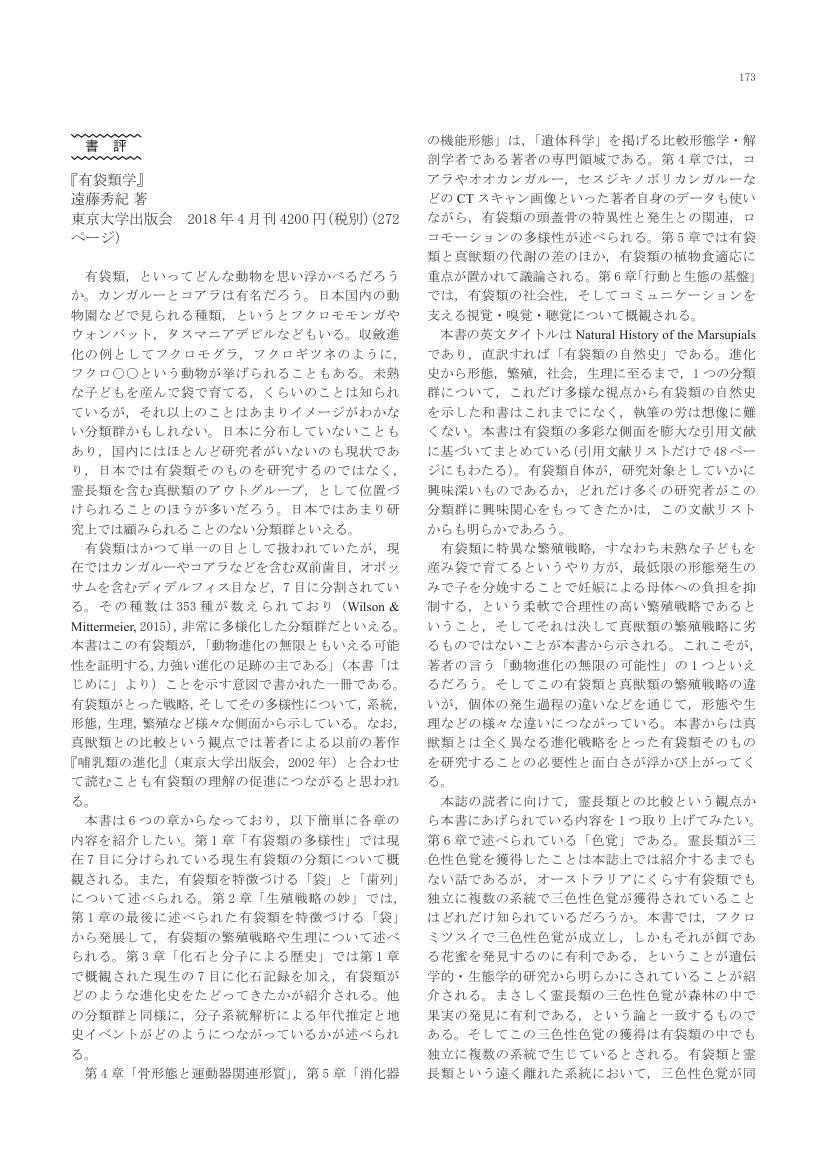80 0 0 0 OA 世界哺乳類標準和名目録
5 0 0 0 世界哺乳類標準和名目録
2 0 0 0 OA 防長海岸の漁村
- 著者
- 新宅 勇
- 出版者
- 一般社団法人 人文地理学会
- 雑誌
- 人文地理 (ISSN:00187216)
- 巻号頁・発行日
- vol.8, no.1, pp.34-46,79, 1956-04-30 (Released:2009-04-28)
- 参考文献数
- 35
Suo-Oshima, the main island in the west part of the Seto Inland Sea, lies between Japan proper and Sikoku. It is 158 square kilometres in area and of 406 inhabitants in every square kilometre. Because of the lack of the arable land, with its over-population, their daily life has been based on the utilization of the coast and its emigrants.The characters of the villages are as follows: Agenosho-Ura (Ura means ‘bay’) and Kuga-Ura are simply fishing villages, which were under the protection of the fishing right as Otate-Ura during the age of former clan. Otate-Ura gained its name because the villagers gave silver towards the government fund. Other Mura-Ura, called Ha-Ura in another name, are half-farming and half-fishing villages which have developed since the Meiji era.The chief products are sweet potatoes, mandarin oranges and dried sea-slugs. The villages are distributed in masses at the lower parts of the coast.The seine by sardine boats comes first in fishing. The individual administration of the first stage of Capitalism is carried on in Agenosho-Ura and in Kuga-Ura.The cooperative administration of stock system is in the other Mura-Ura. The fishing with a rod is for catching sea-breams, horse-mackerels, cuttlefish etc. Okikamurojima is famous for it. In Nasakejima of Yuda-Mura this way of fishing is practised by a Kajiko, child sea-man, employed for that purpose. The center of the net-fishing of sea-breams is Agenosho-Ura holding the 50 per cent of the whole island in the operation with roller. An octopus-trap is popular through-out the island, the west part of which is more famous.After all, in the fishing villages of Suo-Oshima they support a small way of living, relying upon their efficiency of labour, such as a side-job, emigration and a subsidiary work. As far as the number of fishing boats is concerned, in fishing villages it remains comparatively unchanged and the mechanization of the boats is advanced; while in half-farming and half-fishing villages the number has been rapidly increased since the Meiji era and their mechanization is unfavourable.
1 0 0 0 動物園飼育下サル類の簡易で安価な体脂肪率測定法
- 著者
- 木村 直人 寺尾 由美子 鏡味 芳宏 東峯 万葉 廣澤 麻里 岡部 直樹 新宅 勇太 伊谷 原一
- 出版者
- 日本霊長類学会
- 雑誌
- 霊長類研究 Supplement
- 巻号頁・発行日
- vol.33, pp.59-60, 2017
<p>日常的な動物園飼育下サル類の栄養評価は,飼育員の観察眼に頼った主観的評価となることが多い。客観的な評価法としてよく用いられるのは体重測定であるが,栄養評価に重要な体脂肪率は分からない。体脂肪率の測定法にはCTやDEXA等があるが,いずれも機器が大型であったり高価であったりするため動物園では実用性に乏しい。本研究は簡易で安価,かつ客観的な栄養評価を実施するためイヌ用の体脂肪計が応用できないか検討するとともに,体サイズやサル種によって標準的な体脂肪率に違いがあるか否か調べることを目的とした。検査や治療等の目的で麻酔をかけられ不動化された個体のうち,体重600g以上のリスザルからチンパンジーまでを対象とし,測定部位に外傷や皮膚疾患のないこと,消毒用アルコールに対する過敏症をもっていないこと,妊娠または授乳中ではないことといった諸条件を遵守した。①体重測定,②ボディーコンディションスコア(以下BCS)評価,③身体計測,④皮厚計測,⑤伏臥位にてイヌ用体脂肪計(花王ヘルスラボ犬用体脂肪計IBF-D02®)を用いての体脂肪率測定,⑥獣医療上必要に応じて実施される血液検査の6項目を実施した。結果,キツネザル科からヒト科までの20種86頭から90件のデータを得た。体脂肪率の最低値は10%未満(マントヒヒ♂),最高値は30.7%(カニクイザル♀)であった。体脂肪率の測定は1分ほどでできた。皮厚値と体脂肪率,BCSと体脂肪率の間でそれぞれ正の相関傾向が見られ,イヌ用体脂肪計がサルの体脂肪率測定に応用可能であることを確認した。皮厚値と体脂肪率の散布図における象限分析の結果,体サイズ別で標準的な体脂肪率に差が出る傾向がみられた。このことはサル類において体サイズごとに標準の体脂肪率が異なる可能性を示唆している。イヌでも犬種ごとに標準体脂肪率が異なることが知られているので,今後はデータ数を増やしてサル種ごとの標準体脂肪率を求めていきたいと考えている。</p>
1 0 0 0 OA 瀬戸内延縄漁村の変貌 : 豊島と粭島の場合
- 著者
- 新宅 勇
- 出版者
- 地理科学学会
- 雑誌
- 地理科学 (ISSN:02864886)
- 巻号頁・発行日
- vol.4, pp.1-5, 1965-07-25 (Released:2017-04-08)
1 0 0 0 OA 山口県内海漁村と干拓
- 著者
- 新宅 勇
- 出版者
- 一般社団法人 人文地理学会
- 雑誌
- 人文地理 (ISSN:00187216)
- 巻号頁・発行日
- vol.15, no.3, pp.306-320, 1963-06-28 (Released:2009-04-28)
- 参考文献数
- 27
- 著者
- 新宅 勇太
- 出版者
- 日本霊長類学会
- 雑誌
- 霊長類研究 (ISSN:09124047)
- 巻号頁・発行日
- vol.34, no.2, pp.173-174, 2018-12-20 (Released:2019-01-10)
- 参考文献数
- 2



